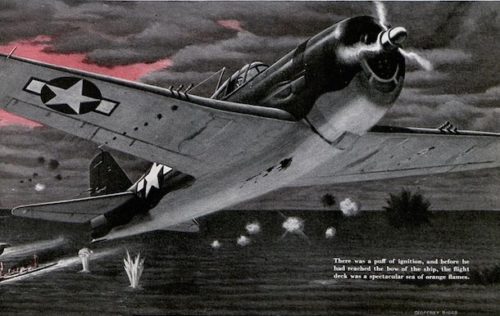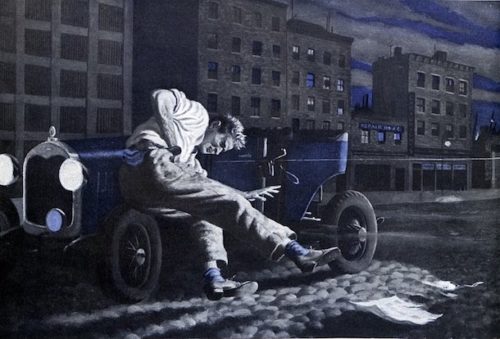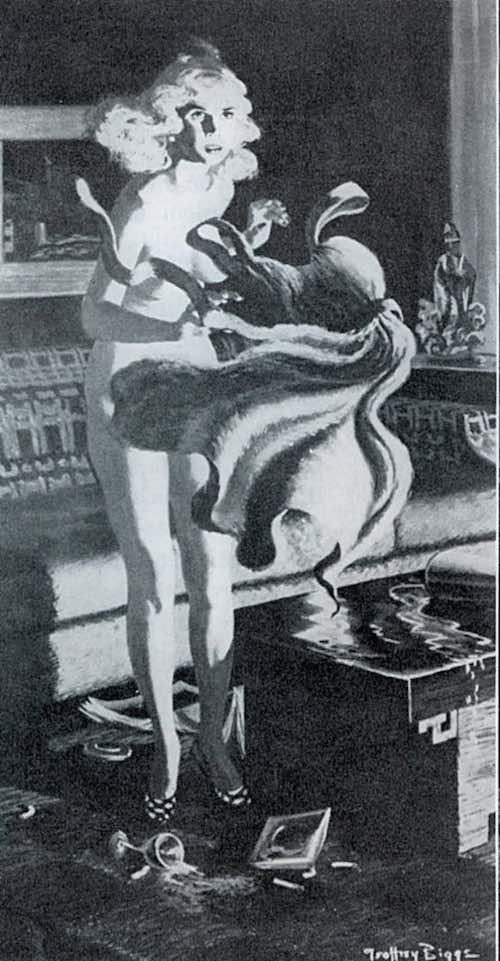The artist Geoffrey Biggs (1908-1971) took pride in getting the story right. He painted with clarity and precision and researched his subjects thoroughly. When he illustrated stories for The Saturday Evening Post and other magazines, he read each story carefully to make sure his pictures matched the author’s words. But he met his Waterloo on the fateful day he tried to paint the naked truth.
Illustrators for the Post were often required to correct errors in their paintings. If the editors didn’t catch mistakes, vigilant readers were always quick to write in and point out even minor flaws in costumes or backgrounds. It became a game with readers, who, in days prior to television, would study the illustrations carefully and compare them against the text of the story.
Biggs was one of the more careful illustrators, but it wasn’t easy to get all the details in a story right — especially because he illustrated a wide variety of challenging subjects. Some required him to learn about complex war machines:

Click to Enlarge
Other stories required him to portray foreign lands accurately:

Click to Enlarge
He painted authentic pictures of hot rods on city streets:

Click to Enlarge
And if he was called upon to paint a civil war scene, you can bet he got the details of the uniforms and rifles just right:

Click to Enlarge
Then one day in 1948, the Post assigned Biggs to illustrate a story by Donald Hamilton titled “The Steel Mirror.” Biggs studied the text and chose to paint the scene where a woman angrily takes off her dress and throws it at a man:

When he proudly presented his finished picture to the Post, the art editors gasped. They couldn’t possibly print such a picture. But Biggs didn’t make mistakes; he showed his editors the passage in the story describing how the woman took off her dress, leaving her naked. The editors were not impressed when Biggs pointed out how he had strategically positioned the dress so that not too much was revealed.
What could they do? Biggs had accurately painted the story they had assigned him.
The editors retreated to confer. A few days later, they called Biggs and notified him that he would have to change his picture because it did not conform to the text. They’d gone back to the author and instructed him to rewrite the story to say that the woman remained dressed in her underwear. They showed Biggs the new text: “she stood there in her underthings…” Biggs knew when he was beaten. He modified his painting to add underwear so that it once again reflected the text accurately:

That was the day that illustrator Geoffrey Biggs learned the valuable lesson that “accuracy” can be a subjective thing.
Become a Saturday Evening Post member and enjoy unlimited access. Subscribe now




Comments
Bob McGowan– Thanks for your comment; yes, Biggs was not one of the better known illustrators for the Post. Despite all the illustrations that he painted, he is probably most fondly remembered today for this valiant effort to test the boundaries of nudity. (He was later interviewed about it in a book about how to become an illustrator for the Post). I’m sure that Hamilton, the author of the story, was not pleased with Biggs for shining a spotlight on the scene he’d written.
I’d never heard of Geoffrey Biggs before, David. He’s very talented and I can see why the POST liked his artwork. He really could paint a lot of various people, places and things in such a way you might not realize it’s the same illustrator.
I have no problem with the original 9/11/48 illustration, but I can see why he was forced to take THIS cold war blonde from an R-rating to PG-13. Even in the first one, the bottom line on her front was still covered, though scarcely.
I’ve missed your column lately! Don’t be a stranger. Have a nice Christmas. I’ll try to do the same, dodging all kinds of slippery slopes having nothing to do with skiing.